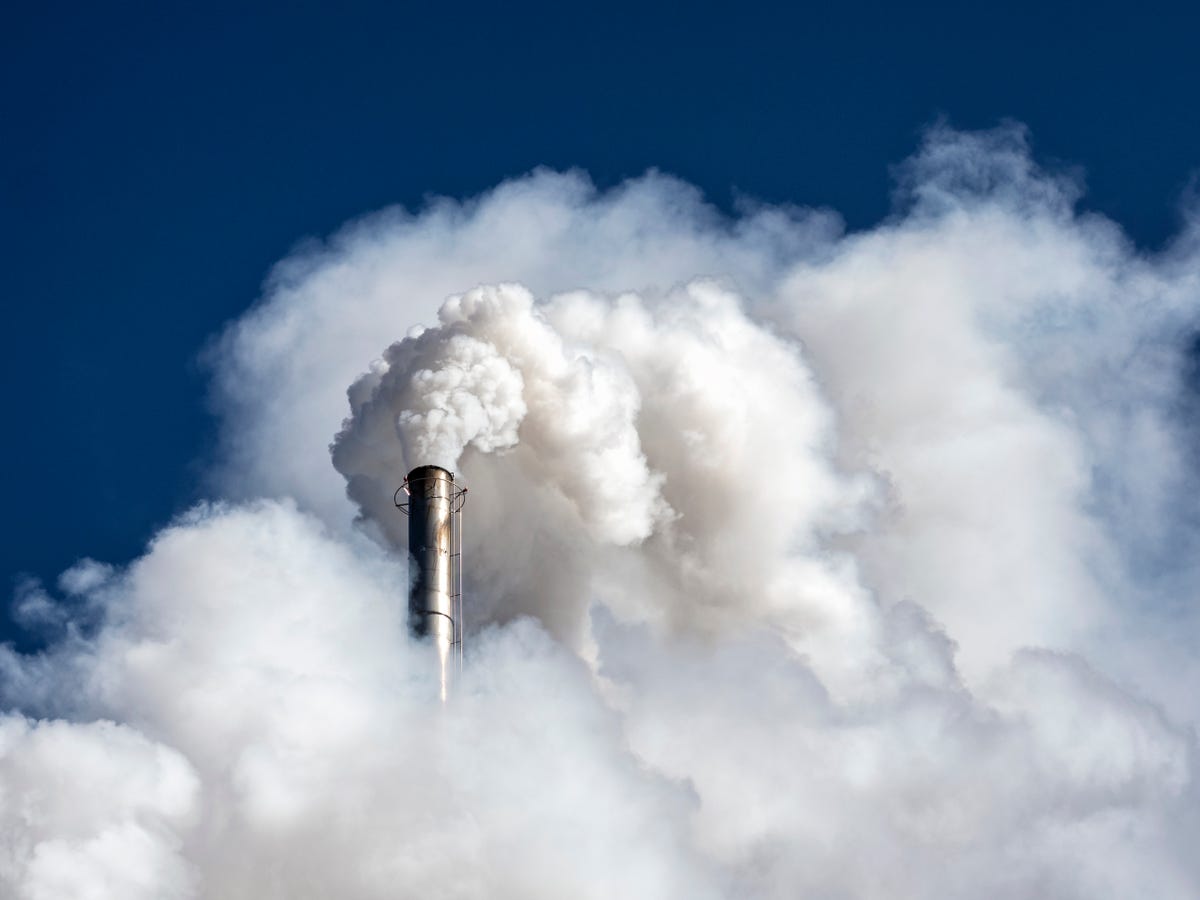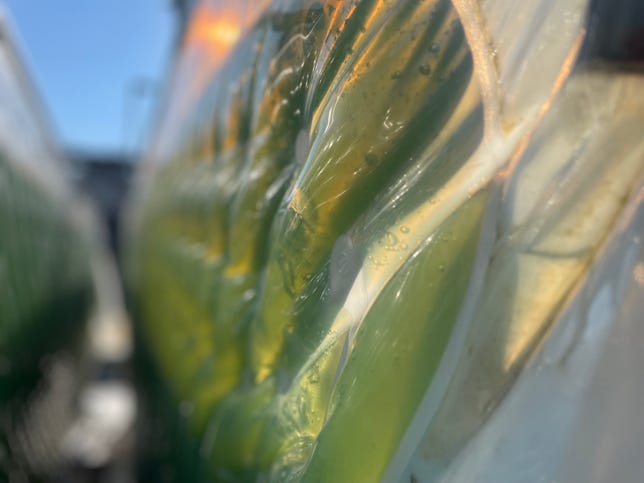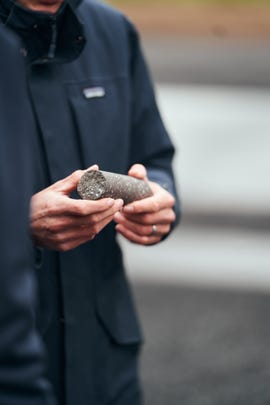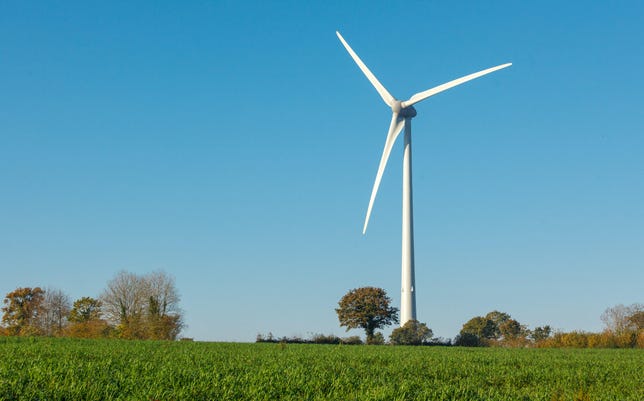This story is part of Choosing Earth, a series that chronicles the impact of climate change and explores what’s being done about the problem.
A pair of 2,000-gallon water tanks standing 15 feet tall occupy a cordoned-off portion of a parking lot down the street from Georgia Tech University’s Carbon Neutral Energy Solutions Laboratory. They’re being used to grow algae, but in an extreme and novel way.
Clear bags filled with a green, mucousy substance float in water while hanging from metal pipes nearby. The bags have tubes sticking out of them, being fed both water and carbon dioxide. That substance, algae, is the key to this whole experiment.
Algae are photosynthetic organisms found in water that, like plants, eat up carbon dioxide and produce oxygen. Algae alone produce 50% of the oxygen in our atmosphere. Researchers at Georgia Tech are seeing if it’s possible to take existing carbon dioxide in the air, capture it and feed it to the algae. Once the algae is refined, it can be used in things from food to fuel.
As an environmental catastrophe looms, researchers are looking at unique solutions such as Georgia Tech’s algae experiment to combat climate change. The UN is urging governments to bring carbon emissions down to net zero by 2050, a difficult task considering that 84% of the world’s energy comes from the burning of fossil fuels, which is a significant source of the greenhouse gas emissions driving the climate crisis. Letting emissions get out of hand could lead to famine and more extreme weather events, but a rising population and increasing energy demands make it difficult to curb our output.
Direct air capture, or DAC, is a technological process that sucks carbon dioxide out of the air and serves as one part of a multifaceted approach to combat climate change. While the DAC industry is still in its nascent stage and has been criticized as too expensive, it’s already embedding itself as an important technology, having secured support from governments around the world.
One person who has high hopes for this process is Chris Jones, chair of the School of Chemical and Biomolecular Engineering at Georgia Tech University. It’s his team that’s looking at products that can be made with the help of DAC, such as algae.
“We think of CO2 as a waste product. Direct air capture is the creation of the waste management business that handles that,” said Jones. “Carbon started underground in the form of coal, gas and oil, and we’re just putting it back underground, where it belongs.”


A carbon countdown
Humans have dumped an estimated 1.5 trillion tons of CO2 into the atmosphere since the Industrial Revolution. Last year, carbon emissions rose by 6% to 36.3 billion tons, according to the International Energy Agency. An October UN Environment Programme report says global governments, especially richer, carbon-polluting countries, are “falling pitifully short.” United Nations Secretary-General António Guterres said in a video message, “We must close the emissions gap before climate catastrophe closes in on us all.”
The bleak analysis says that humans are on track to increase global temperatures 2.8 degrees Celsius by the year 2100, landing far above the 1.5 degree target set by the 2015 Paris agreement.


Algae inside photoreactor bags at Georgia Tech University.
Thomas Igou / Georgia Tech University“Every little digit that we shave off is a lesser catastrophic outlook,” UNEP Executive Director Inger Andersen said to the Associated Press.
DAC isn’t meant to clean up the atmosphere so that humans can continue polluting. It’s not a magic solution that’ll save humanity. But it is expected to play a major role.
The technology is an important topic of discussion at the COP27 conference happening in Egypt now.
“Direct air capture’s role is in the long-term climate mitigation plan to bring down atmospheric CO2 levels once all CO2 emissions have stopped,” said Carlos Härtel, chief technology officer at Climeworks.
As DAC tech develops, it’ll prove useful as the world’s energy infrastructure shifts to cleaner alternatives. But it’ll need constant development, and government incentives could help.
The immediate goal for global governments is to cut carbon emissions in half by 2030. This will include shifting away from fossil fuels as quickly as possible and moving toward wind, solar and nuclear. But that doesn’t mean DAC doesn’t have a role to play.
“We need to go to zero in terms of fossil fuel production and consumption, and then use the DAC to clean up the mess that we have already made,” said Soheil Shayegh, a scientist at the European Institute on Economics and the Environment, or EIEE.
Advances in DAC
In 1999, Klaus Lackner, a chemical engineer at Arizona State University, was the first to recognize direct air capture as a way of combating climate change.
Here’s how it works: As air passes through a filter lined with chemicals, little bits of CO2 get captured. Once the CO2 is separated, it can either be stored underground or be used to make products, such as carbon fiber or the fizz in a soda. There are about 412 CO2 particles per million in the atmosphere, meaning giant fans have to suck in a lot of air to capture just one ton. While that number might seem small, CO2 was under 300 parts per million in preindustrial times.


Mineralized CO2 at Climeworks’ Orca Facilitiy
ClimeworksThere are now 19 DAC plants worldwide with Switzerland-based Climeworks, Canada’s Carbon Engineering and the US’ CarbonCapture pushing innovation in the field.
The largest DAC facility is Climeworks’ Orca plant in Iceland. Orca is a $10 million carbon capture facility that aims to suck up 4,000 tons of carbon a year, or 0.00001% of annual emissions. And with government tax credits, the cost of capturing carbon will be more manageable for companies. Oil giant Occidental has plans to set up 30 DAC plants in Texas, where it hopes to store 3 billion metric tons of carbon underground.
Climeworks is already working on a second DAC facility 300 meters away from its first in Iceland called Mammoth. It’s much larger than Orca, and meant to capture nine times more CO2.
DAC needs to scale up quickly. Right now, all 19 plants account for 0.01 metric tons of carbon capture per year. They need to reach 85 metric tons by 2030 and 980 metric tons by 2050 to help hit current climate targets, according to the IEA. Big Tech is also jumping on board, with Google, Meta and others investing nearly $1 billion into DAC.
Researchers are already imagining new ways of capturing carbon. One idea from the company CO2 Rail involves putting DAC carts on trains. CO2 Rail says that its DAC train carts could remove up to 3,000 tons of carbon per year. Students at Eindhoven University of Technology in the Netherlands are touring ZEM, or Zero Emission Mobility, a concept car that sucks up CO2 as it drives.
At Georgia Tech, algae growth was about 5% higher in lab experiments, showing that growing plants by utilizing captured carbon is both possible and not harmful.
There’s debate around whether DAC should be limited to large plants near “sinks,” or areas where carbon can easily be stored, like the volcanic rock in Hellisheiði, Iceland, where Orca and Mammoth are located. Georgia Tech’s Jones envisions a future where small DAC machines the size of cars can be sprinkled around the world, some near major areas of carbon emission, like cities.
Whether it’s big or small, DAC will take time to scale up.
“If you want to have it as a technical solution to carbon removal at the gigaton scale from 2050 on, you cannot wait until 2049,” said Härtel. “We have to start today. We have no time to lose.”
DAC is expensive and not a perfect solution
This year’s Inflation Reduction Act, the most expansive climate legislation ever signed into law, gives a $180 tax credit per ton to companies that capture carbon and store it underground.
DAC is part of a larger strategy tied to the Inflation Reduction Act to move America away from fossil fuel dependency. The act includes $128 billion for renewable energy, $30 billion for nuclear power and $13 billion in electric vehicle incentives, along with billions in local government incentives.
Critics say policymakers are making a mistake by giving generous incentives for carbon capture, largely backed by the fossil fuel industry. Sucking up carbon requires expensive materials and large facilities. Funds meant for carbon capture could be put instead toward renewables, which would prevent carbon from being emitted in the first place.


Wind turbines, such as this one in France, are the top source of renewable energy among corporate buyers but solar energy is on the rise.
Stephen Shankland/CNETThe cost of running the system is a constant concern. For example, it costs $800 to remove one ton of CO2 with Orca, according to Climeworks. The company did note that Orca is not yet optimized to run efficiently and that the cost will go down over time. How far it goes down is still being debated in the scientific community, but Climeworks says it’s confident it will cost between $250 and $350 a ton in the 2030s.
The EIEE’s Shayegh said the magic number per ton of carbon captured is $100, and that’s before expenditures on conversion or in-ground sequestration. Best-case scenarios put the cost per ton for capture and conversion or sequestration at $250 by 2050, he added.
Härtel said costs need to go down to $150 per ton captured and sequestered. He feels that $100 per ton, in today’s money, likely won’t be possible by 2040. Given the slim margins, it’s also why he feels having large facilities near sinks will be most cost effective, as opposed to small DAC machines scattered around the globe. It’s also why Härtel is skeptical that downstream products made with captured carbon will make much of an impact since the scale of the problem is so large.
Those numbers don’t impress experts who believe the money should be spent elsewhere.
“It is a bad idea to pick the tool that costs a lot and has very little effect on atmospheric carbon dioxide, even though it does reduce it,” said Charles Harvey, professor of environmental engineering at the Massachusetts Institute of Technology. “Because if you were to have used the resources for a different tool, like building wind, solar and power storage, you would have taken a lot more carbon out of the atmosphere.”
In Harvey’s view, taking carbon out of the atmosphere is far more difficult than not emitting it at all. He also worries that DAC is being used as a cover for fossil fuel companies to continue producing. It’s actually possible to use captured carbon for enhanced oil recovery, known as CO2-EOR, a process through which carbon is turned into a near-liquid state and pumped underground where oil is. The CO2 fills the cracks underground, creates pressure, forces the oil up and makes it easier to extract. Refining and burning oil extracted by CO2-EOR can negate the benefits of CO2 sequestration, although the oil sold could offset the cost of capturing carbon.
“There’s a reason why oil companies are promoting these ideas,” said Harvey. “And that’s because they want to avoid the option of just not burning as much oil.”
We have to move now
This year has been riddled with climate disasters. Hurricane Ian hit Florida, China has endured a yearlong drought and Pakistan saw some of the worst flooding in history, with 1,735 deaths reported so far. There have been at least 29 $1 billion-plus climate events this year alone. These disasters will only increase in intensity as the planet warms.
DAC, along with greener energies, will take creative thinking, experimentation and financial incentives to net a return. Researchers at Georgia Tech are hoping DAC-induced algae growth can contribute to a circular carbon economy, sucking in CO2 and making products to offset costs.
As quickly as we need to cut our dependency on fossil fuels, humans “continue to find ways to waste energy in just really stupid ways that makes demand grow really fast,” Jones said. Bitcoin mining alone uses as much energy as Argentina, and fossil fuels are still the cheapest and most readily available supply of energy. But that doesn’t mean it needs to be our primary source of fuel forever.
“I think we’re going to be stuck with fossil energy for the entirety of your and my life,” he said. “And the question simply is, how quickly can we transition to renewables as much as possible and how do we make the fossil energy as clean and safe as possible? And that’s where DAC comes in.”
